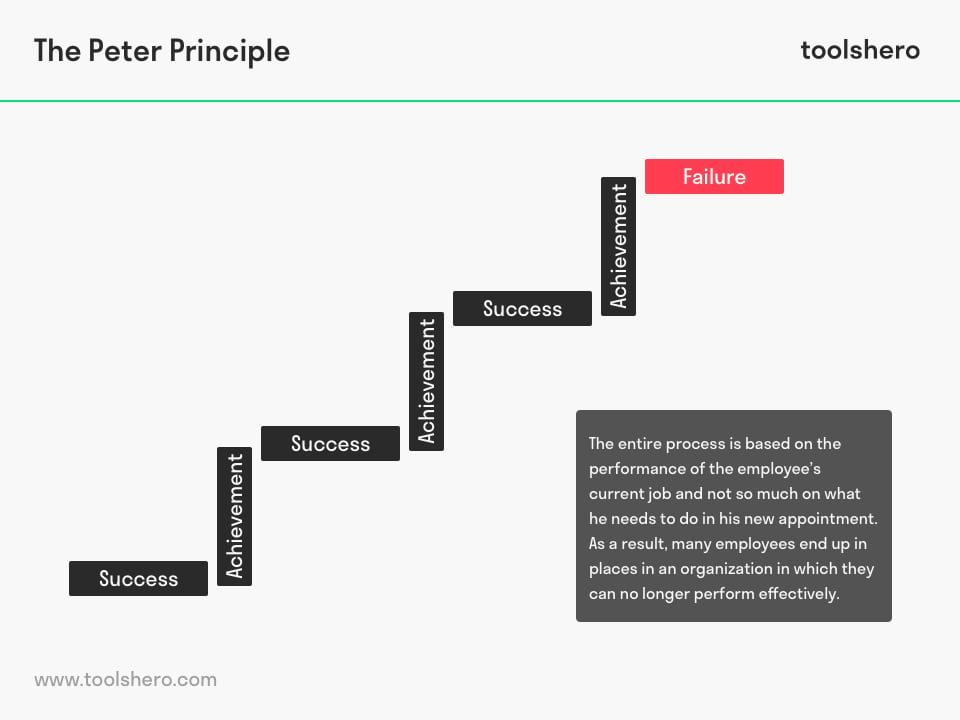Peter Principle explained

Peter Principle: this article describes the Peter Principle in a practical way. Next to what this concept is (definition and meaning), this article also highlights the importance of promotion, other tasks, demotion and an example. Enjoy reading!
What is the Peter Principle?
Everyone will have experienced the following at some point in their life: you work somewhere for a longer period of time and then you get promoted to a managerial position. However, at the end of the day you do not succeed in carrying out the work satisfactorily as this is clearly beyond your level of competence.
The same can also apply to a study or training course. as a result of which someone ultimately fails. This is the basis of the so-called Peter Principle.
The Peter Principle was formulated in 1969 by the American educationalist and pedagogue Dr. Laurence J. Peter and focuses on the field of organizational science.
The definition of the Peter Principle
The Peter Principle states that in a hierarchy each employee rises to their level of incompetence. It is the ceiling that every employee will meet at some point in their career. For some this ceiling may be higher than for others.
Peter Principle: promotion
The Peter Principle is about the employee who functions well in his first job within the hierarchy of the company.
As a result, he is eligible for promotion to a higher position. If he does well, a second promotion follows. Eventually the employee will fail after having been successful several times.
The promotion process ends when the employee does not function properly in his new and final role. It will become evident that he does not have the required managerial skills and characteristics that are part of this new position.
The entire process is based on the performance of the employee’s current job and not so much on what he needs to do in his new appointment. As a result, many employees end up in places in an organization in which they can no longer perform effectively.

Figure 1 – Peter Principle explained
The Peter Principle: other tasks
The Peter Principle shows that successful employees are often promoted once too often and therefore end up in a job in which they do not come into their own. In their previous jobs, on the other hand, they performed excellently.
In most cases, their responsibilities change and they turn into a managerial, planning and controlling roles, which requires completely different skills and insights. A professional is not automatically a good manager who knows how to motivate his employees and how to take decisions.
As a consequence, the new manager will become extremely miserable in his new job and he will have to deal with employees who turn against him. He will become a victim of his own success.
Demotion
Unfortunately, it still happens that employees can run up against their level of incompetence. This has to do with the fact that many organizations still reward the best employee of a team by promoting them to a higher position.
The most experienced employee will get a higher position together with the corresponding responsibility. Unfortunately, from that moment on, the employee’s value to the organization quickly declines.
He is not able to manage his team and achieve a good level of production. However, it is not possible to demote him to his previous position, in which he functioned well.
Firstly, that place has probably already been taken by his successor and secondly, both the employee and the organization will not want to admit that an error of judgement has been made. As a result, the new position of the employee will be maintained, resulting in either voluntary resignation or imminent dismissal.
Incompetence
If this process continues long enough, an employee will eventually reach their level of incompetence.
If this happens to all employees it can happen that over time, the organization will have a large number of incompetent employees in managerial positions, which will have disastrous consequences.
Most of these employees will develop a number of defence and suppression mechanisms to mask their poor competences. For example, they will not engage in confrontations with their subordinates, who should actually be held accountable for their behaviour.
They will also pay a disproportionate amount of attention to matters that are not essential to the proper execution of the work and they are likely to postpone major decisions.
Practical Peter Principle example
Imagine a successful business in which its top salesman stands out because of his sales talent. As a result, he is promoted to sales manager and he performs his duties excellently for a number of years. For this reason he is appointed commercial director after a while.
After his successful periods he starts showing signs of failing in his performance.
He has a demotivating effect on his staff, has too little knowledge of annual figures and sales promotions and he does not know how to manage the staff members in the sales team. As a consequence, turnover is stagnating and absenteeism is rising at an alarming rate.
In his function as commercial director, he does not engage in talks, is quickly annoyed when staff come up with good ideas, is poorly prepared when the financial figures are discussed and he does not know how to chair team meetings effectively.
The result is that he feels miserable in his current position and the car company is at a loss what to do with this malfunctioning commercial director.
Depending on his age, he will look for new work. The older employee will bide his time until retirement and will therefore run the risk of being sidelined by company. It also happens that the employee in question falls ill as a result of which a readjustment to work process may have to be started up.
The above example shows that promoting someone to a higher position should not be an ‘automatic’ process.
A company should have talks with the employee involved, so that it can learn all about this person’s level of knowledge, skills and ambitions. Experience is a good thing, but this does not automatically make an employee the best person to be promoted to a more responsible job.
It’s Your Turn
What do you think? What is your experience with the Peter Principle? Do you recognize the practical explanation or do you have more additions? What are your success factors for dealing with incompetence and hierarchy?
Share your experience and knowledge in the comments box below.
More information
- Fairburn, J. A., & Malcomson, J. M. (2001). Performance, promotion, and the Peter Principle. The Review of Economic Studies, 68(1), 45-66.
- Lazear, E. P. (2004). The Peter Principle: A theory of decline. Journal of political economy, 112(S1), S141-S163.
- Peter, L. J., & Hull, R. (1969). The peter principle (No. 04; RMD, PN6231. M2 P4.). London: Souvenir Press.
How to cite this article:
Mulder, P. (2018). The Peter Principle. Retrieved [insert date] from Toolshero: https://www.toolshero.com/management/the-peter-principle/
Original publication date: 02/02/2018 | Last update: 11/08/2023
Add a link to this page on your website:
<a href=”https://www.toolshero.com/management/the-peter-principle/”>Toolshero: The Peter Principle</a>












